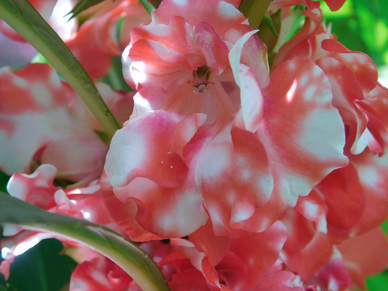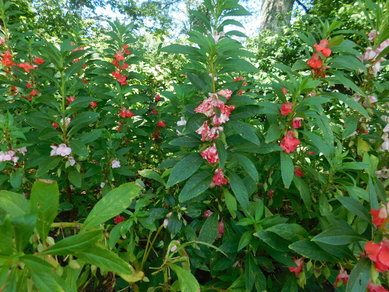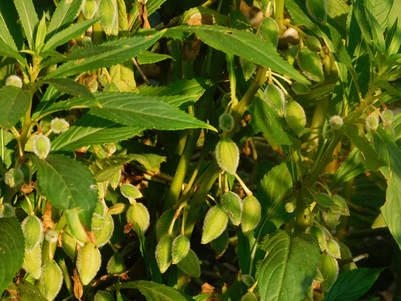 I consider the Garden Balsam to be one of the most beautiful flowers in my garden. I just love its unique, tropical appearance and its stunning flowers! Mrs. Grieve calls it "one of the showiest of summer and autumn flowers" and G. Francis, in The Favorites of the Flowers Garden (1844) says that it "may be ranked amongst the most elegant annuals that the warmest climates have afforded us". Impatiens balsamina is a native of India, China and Japan. The exact date of its introduction is uncertain, but we do know that it was cultivated by John Gerard in 1596. It was first offered in America by J. Townley of Boston in 1760.  Garden Balsam at Monticello Garden Balsam at Monticello Thomas Jefferson planted "Double Balsam" at Shadwell on April 2, 1767, sent "Balsamine" from Paris to Francis Eppes in 1786, and, in 1812, received "seed of some very superior Impatience Balsamina" from the Philadelphia seedsman, Bernard McMahon. Although seldom seen in modern gardens, it was well-known in the 19th and early 20th centuries. The most popular were the double, or Camellia flowered varieties. Walter Elder praises it highly in his article for The Gardener's Monthly, entitled "Despise Not the Day of Small Things" (1863): "Of annuals, what can be compared to the Camellia Balsam, as double as a rose; no wax work nor any imitation of man, can compare with it in rich and dazzling beauty". But my favorite is 'Peppermint Sticks', which has strikingly beautiful red and white mottled flowers. Although 'Peppermint Sticks' is a newer variety from Holland, its amazing colors are nothing new. As early as 1807, Alexander McDonald mentions a variety "with large double variegated scarlet and white flowers". Walter Elder, writing in 1863, extols "The white and scarlet spotted" balsam as "unequaled among flowers". And I quite agree! When they are in bloom, I often find myself just staring at them in awe! Like so many of our treasure garden flowers, it has been given many names by its admirers. Among these are Rose Balsam, Lady's Slipper, Somer-sots, Garden Jewelweed, Tree Impatiens, and Touch-me-not. The last is a reference to the way the ripe seed pods burst open when touched, scattering the seeds some distance from the plant. Impatiens is derived from this same fact, and I am told that all members of the genus have this same characteristic.  G. Francis also relates "a curious circumstance" of the seeds. He writes that "those which are fresh, or of last year's growth only, seldom produce double flowers; but to have these, you must sow seeds from three to nine years old". Joseph Breck said much the same thing in his Book of Flowers (1851). I am definitely going to be experimenting with this in the years to come! So far as I know, I. balsamina has no medicinal use. However, the Japanese used the juice of the plant prepared with alum to dye their nails red. G. Francis writes that "the Turks represent ardent love by this flower". With us, however, it symbolizes impatience. I often wonder why this beautiful plant has fallen out of favor in recent years. It is one of the easiest flowers to grow, and children will be delighted by the bursting seed pods! It truly is a must for any old-fashioned flower garden.
6 Comments
Reply
Leave a Reply. |
AuthorI am a passionate gardener and seed-saver, who also enjoys playing the violin and accordion, running, spending time with my 4 golden retrievers, keeping chickens, photography, and reading. Archives
March 2019
|

 RSS Feed
RSS Feed
